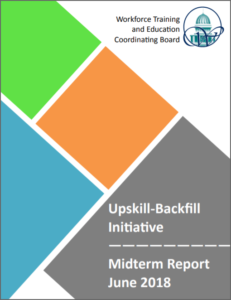Upskill-Backfill Initiative
Washington businesses face a growing labor shortage, as the economy booms and unemployment rates dip to their lowest levels in 40 years. This makes it harder than ever to recruit frontline staff. Meanwhile, current employees need training to advance and increase business productivity. An aging workforce creates more challenges. Every day, employees with key skills and deep experience retire, leaving critical positions unfilled.
A Solution that Works for Washington Businesses
A new demonstration project, Upskill-Backfill, is helping Washington workers gain skills to move ahead in their careers, while helping new workers “backfill” into newly created openings. It’s being done across key sectors—from healthcare to aerospace to manufacturing. Each project involves multiple employers, putting in time, energy, and significant funding to train their existing workforce, while making room for entry-level workers and opening doors to expanded business opportunities.
The Upskill-Backfill Initiative started in 2016 when Governor Inslee invested almost $2 million in federal funds to test drive new ways to build stronger partnerships between the public and private sectors. The initiative also jumpstarted at the ground level the state’s workforce development plan, “Talent and Prosperity for All,” or TAP. The state’s Workforce Board was asked to lead the project. The initiative’s success has inspired other Washington businesses to seek similar solutions.
Download the Upskill-Backfill Midterm Report or Case Study about lessons from the Upskill-Backfill Initiative.
Upskill-Backfill: Keep Your Best Employees Working for You
When businesses invest in “upskilling” their employees, they become even more valuable—and more likely to stay. This training is more important than ever, especially as workers struggle to keep pace with changing technology. When training is built into the workday, employees are better able to juggle work and life. Tar-geted training can also help older workers transfer knowledge to a younger generation before they leave.
Reduce recruitment costs by growing your own
Hiring and training new employees can be costly. A survey by the Society for Human Resource Management found the average cost-per-hire is $4,129. Retaining valued employees through regular training is often more economical, and practical, than recruiting. Bonus: Employers avoid the risk of a bad hire and eliminate the time it takes to onboard new people.
Maintain market competitiveness through tech training
As technology advances, employees need new digital skills to keep up with the changes, even in jobs that used to sit apart from technology. Carving out time for employees to gain these skills can benefit businesses in the long term.
Improve employee loyalty through professional development
Many employees, especially younger workers, seek employer-delivered training. But making time, or paying for training, can be challenging. A National Skills Coalition report said workers who expressed interest in gaining new skills reported being “too busy at work” and training “was too expensive.” Employers who provide training boost worker loyalty—and productivity. The demonstrated commitment to their employees‘ advancement can improve the company’s competitive edge.
Best Practices: Don’t Keep Your Training Opportunities a Secret!
To retain and attract employees, share your training opportunities early and often. Let new employees know how to access this training as soon as they start. Also, seek training that you can provide or subsidize. This helps employees know you value them and their advancement. It also helps motivate employees to gain needed skills.
Recognition and promotion
Some employees may not understand how training can advance their skills and career. A recognition program or a clear promotion path can help motivate employees who want to move up—taking themselves, and your business, to the next level.
Discuss career goals
Managers at larger companies can also help employees craft career development plans. Even smaller companies can sit down with employees from time to time, to discuss career goals and how to get there.

